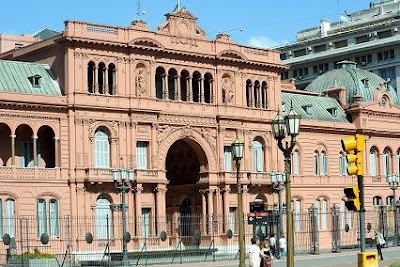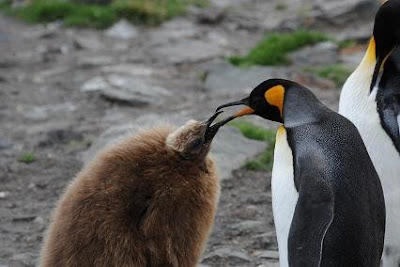 Note the catwalk just below the falls
Note the catwalk just below the falls One of thousands of birds we saw
One of thousands of birds we saw Jan wasn't happy to see this 4-foot long lizard
Jan wasn't happy to see this 4-foot long lizard Coati
Coati Toucan
Toucan Bossetti Waterfalls
Bossetti Waterfalls Looking down into Devil's Throat
Looking down into Devil's Throat A tour boat at the bottom of falls
A tour boat at the bottom of falls As wet as we had ever been
As wet as we had ever beenWith Iguazu Falls, we were introduced to an entirely different experience from Antarctica. There was thick green jungle instead of a treeless landscape. There was 100 degree heat instead of 32 degree cold. There was color instead of black and white. There was relatively flat terrain instead of mountains. There were thundering waterfalls instead of silent icebergs. There were people instead of penguins.
Our three day post cruise package, from Regent Seven Seas Cruises, included an overnight stay at the Argentina’s Sheraton Spa and Resort, the only hotel inside the 136,000 acre Iguazu National Park. The view from our room was magnificent, looking out over the distant Devil’s Throat waterfalls…which constantly emitted an eerie, heavy mist from its churning waters. The entire waterfalls consist of 275 individual falls along 2.7 kilometers (1.67 miles) of the Iguazu River. There are actually 14 miles of waterfalls throughout the giant gorges. The longest waterfall drop is 229 feet. We walked on miles of elevated metal catwalks and trails, which wound in, over and beside many of the waterfalls. To look down into Devil’s Throat, we rode an open air train to a half-mile long catwalk overlooking many river fingers and through a very dense jungle, which lead to the actual viewpoint. It was definitely a highlight, not only of this vacation…but, of all the trips we have ever taken. Rushing water was furiously pounding nearly 200 feet down to the raging river below.
The most memorable part of this escape, however, had to be a one-hour boat ride we took into the base of several waterfalls. The roaring sound made by the cascading falls would have been sufficient to satisfy our sense of adventure. But, the river zodiac ride had just begun when the dark gray skies opened and we were literally deluged by the hardest, wettest cloudburst we had ever experienced (complete with nearby lightning and thunder). The rain pelted us so unmercifully that we were forced to bury our heads behind the seats in front of us in order to avoid the stinging rainfall. That was, without a doubt, the wettest either of us had ever been...outside, perhaps, scuba diving in Moorea, snorkling in the Caribbean, or being ground into the sand while body surfing in Hawaii.
While walking along some of the many trails in the park, we did manage to see a few critters that we had never seen in the wild before: many quati (small, inquisitive animals with tails like a raccoon and snouts much like an anteater)…a single toucan, so high in a tree that all photographs were somewhat on the poor side…a 4-foot long crocodile-like reptile…a 6-inch black, blue and purple butterfly (sorry, no photograph of this very elusive character)…and a wide variety of unusual birds. Unfortunately, we did not see a single monkey.
After our one night stay at Iguazu Falls, we were bussed back to the airport for a short flight back to Buenos Aires and the Melia Hotel (yep, our third stay at this facility). We enjoyed the hotel, several wonderful meals and nearby stores before departing for the Buenos Aires airport the following night. All that was left was our day-long sojourn back to Seattle (via Houston, Texas). We did revisit a restaurant, La Estancia, where we had eaten over 20 years ago. They had a fabulous Argentine Asado (meat barbeque) which we highly recommend.
We think you could say that our 20-day adventure was just that, an adventure! We’re glad that we could share some of it with you by way of this blog. Hopefully, at some future date, you will join us again: Perhaps in person on one of our tours…or, through these words and photos. Feel free to check this site where we will be posting our upcoming travels.
































 Chinstrap Penguin
Chinstrap Penguin













